There is probably no other name that conjours up the traditional trawler style motoryacht than Grand Banks. David Toyer looks over the Grand Banks 47 EU, one of their newest creations.
Grand Banks boats have been built since 1956 and are synonymous with traditional trawler style coastal motor cruiser designs. Over the years these boats have gained a very loyal and enthusiastic following that has given them cult status.
Renowned for their quality and hand crafted finish to the traditional solid timber interiors, linings and joinery; a very distinctive style that included full walk-around decks and high bow sprit, and of course the semi displacement hull, Grand Banks have always been very consistent.
In 2006 there was a significant change, and though the current series of motor yachts still retain all those aspects that are endearing to loyal Grand Banks followers, the all-new hull below the waterline takes the Grand Banks Heritage Series into a new era.
After years of pumping more and more power into an aging semi-displacement hull that was not giving customers the most fuel and power efficient solutions, Grand Banks reacted to customer pressure for a faster and better performing boat by commissioning Sparkman and Stevens to design a new hull capable of 24 plus knots top speeds.
The result is a modified deep vee with the hull extending aft under the boarding platform. This extended underwater running surface, along with propeller tunnels that allow a flatter propeller shaft angle, not only gave the Grand Banks faster speeds by making better use of engine power, but it also trimmed the boat flatter than the old semi-displacement hull and kept a reasonably flat trim angle during the transition from low speed running to high speed planing trim.
At 15’ 3”, the 47’s beam is more than 1’ wider than the popular 42 Heritage model. This wide dimension not only provides for more space and openness throughout the living areas, it also serves to increase stability at sea for an even more comfortable ride.
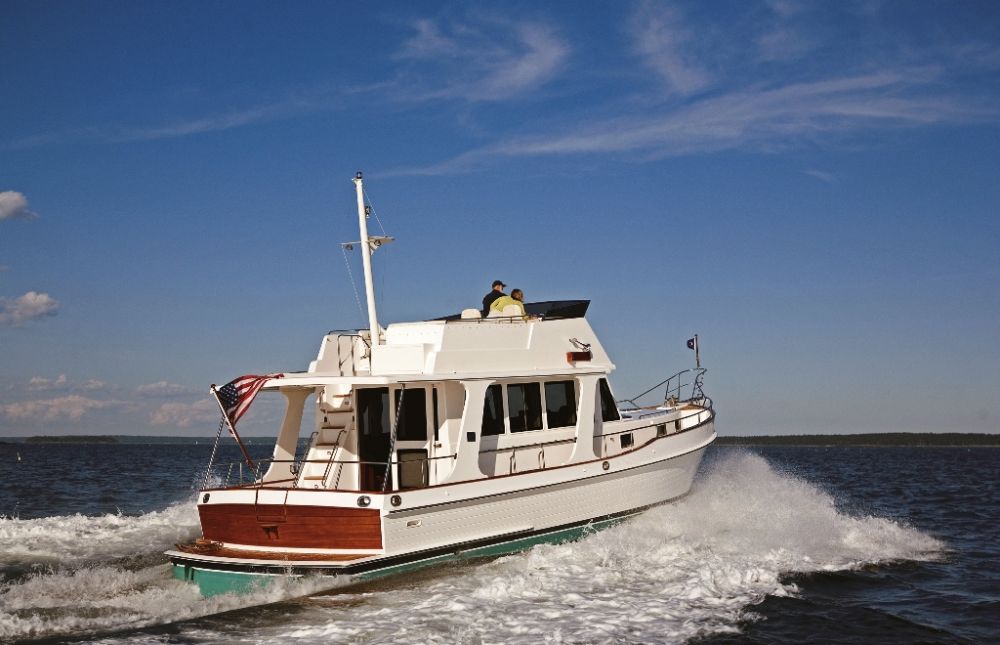
One of the big benefits of this flatter trim is that there is now a much better view from the lower helm station; something that was often an issue given the high bow lines and the big anchor platform. This new hull now encourages faster long haul coastal cruising than previously and the operation of the boat from the lower helm station is a crucial aspect of that lifestyle.
The only issue now may be the cruising range which, depending on engines, load and speed could be not much greater than about 200 to 230 nautical miles with the 2271 litre fuel capacity.
The first of the new Heritage Series 47EU’s was not all that long in Australia before selling during the Sanctuary Cove Boat Show, and the difficulty encountered beating the crowds to get aboard and inspect this boat probably was the best testimony to the popularity of the boat and the interest that the new hull design has engendered.
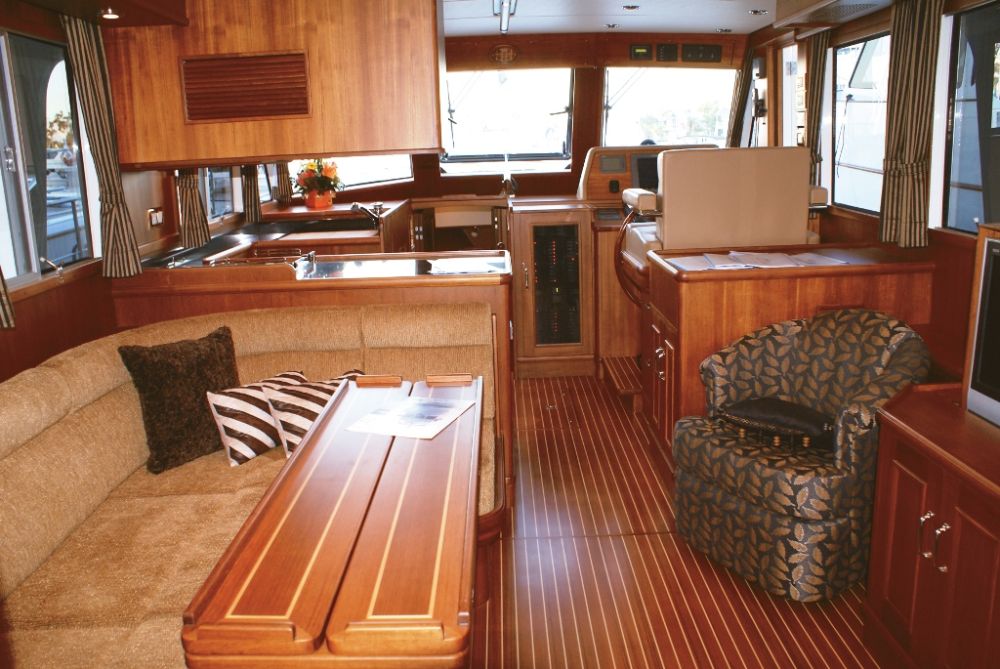
In dimension, the new 47EU is essentially what used to be known as the 44EU, but in mid 2006 Grand Banks adopted the ABYC (American Boat and Yacht Council) standards for boat measurement. Hence the company renamed its models to comply with those standards, which essentially state that overall length includes integrally formed, moulded or welded components of a vessel – and with the moulded hull now extending under the boarding platform, the model was renamed.
As I said earlier, Grand Banks are renowned for their interior being very heavily into teak timber. Veneers are used for all the joinery, bulkheads and most liners, and timber planking is used for the hull liners to both cabins, thereby retaining that touch of old world timber planked charm inside a fibreglass hull.
In spite of an interior dominated by highly lacquered, dark timbers, the open planned saloon deck is very bright and airy. Large windows all the way round open the saloon to the outside, and though the sill level does limit the view when sitting back and relaxing in any of the lounges, you still have that feeling of openness.
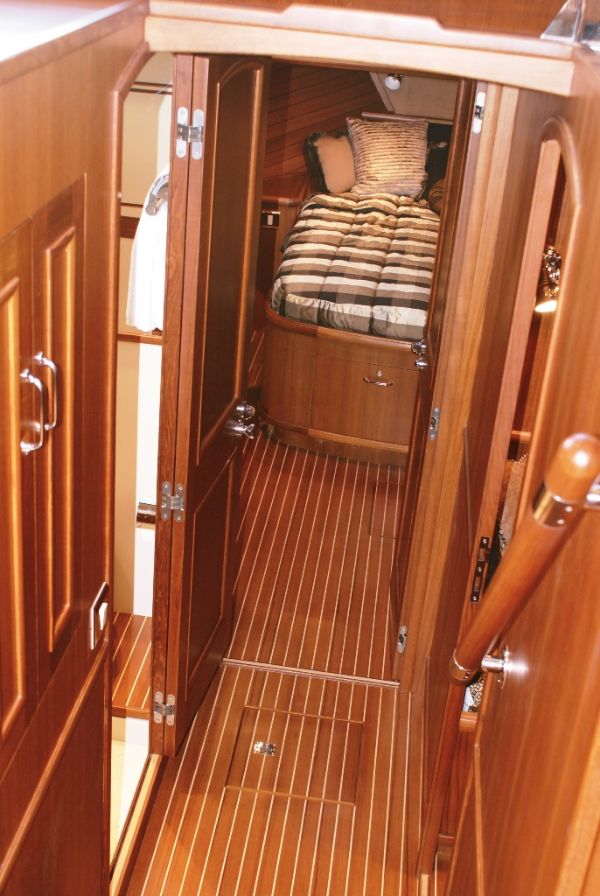
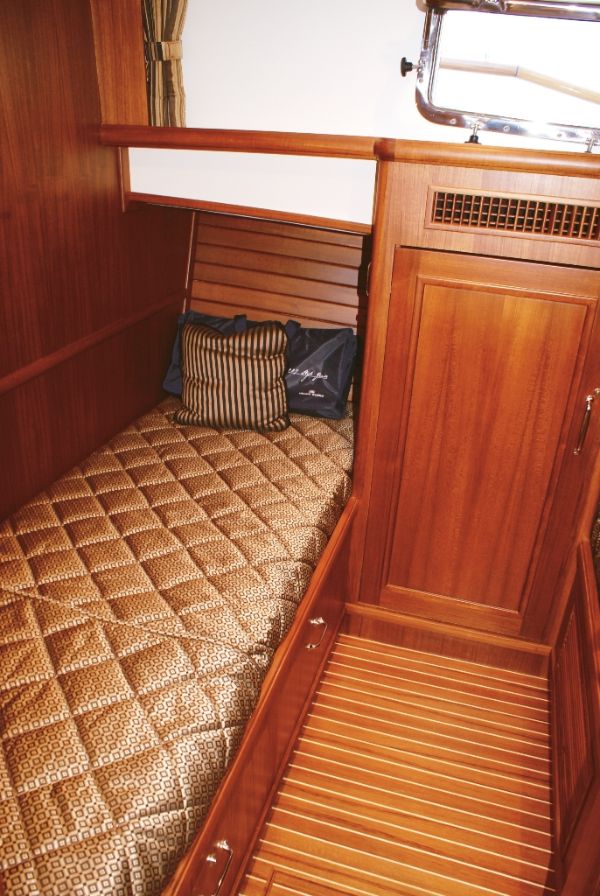
It’s only the overhead cupboard of the galley that creates any form of visual break to the open interior but even this fails to close up or segregate the saloon in any way.
Whether you are preparing food or drinks in the galley, or taking the helm on a slow cruise, you are never left out of the socialising that is going on in the saloon. This single level layout is very user friendly – very sociable.
Marine traditions are hard to break for Grand Banks and it is still one of the few leading manufacturers to build fiddle rails around the edge of all the granite galley bench tops and around the hot plate burners, as well as to the entertainment unit and folding table in the saloon. Surprisingly, there were none around the flybridge table top or the wet bar.
The lower helm station has all the space needed for current electronics and screens. The main switch panel is off to the side where it can be easily seen and a side helm door leads straight out onto the side deck.
Air conditioning is fitted, but with a big central electric opening window at the front, the side and rear doors and some big hatches in the lower cabins, it is possible to catch some cool breezes when at anchor and not need to resort to it.
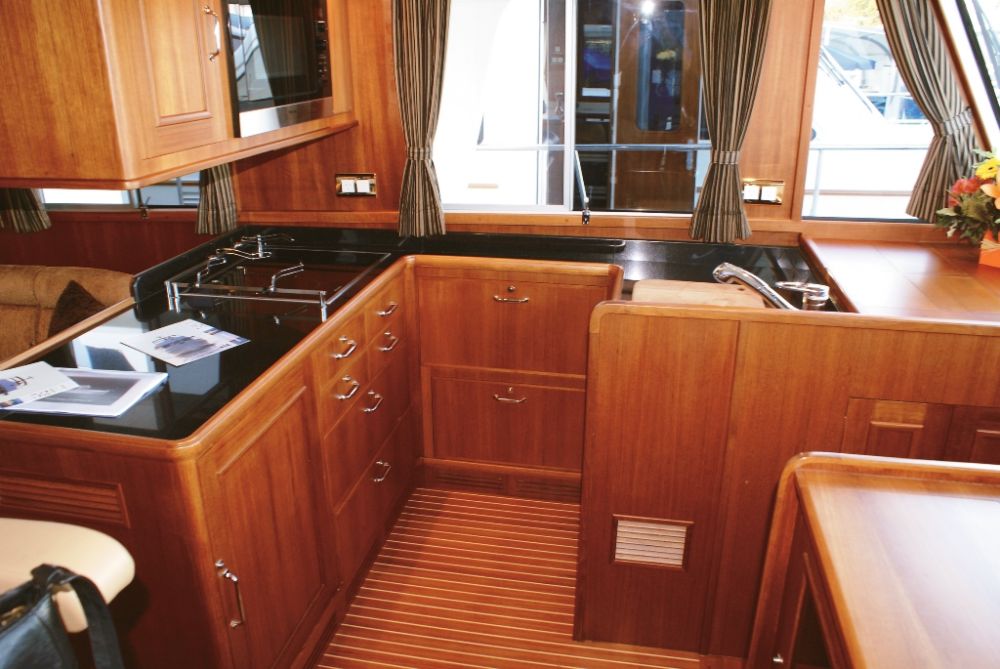
The standard 47EU layout provides a two-cabin, two-bathroom configuration below deck. The forward cabin has an island berth with adjoining ensuite while the second cabin has twin berths, with an option for a double. This second cabin also has the option to be fitted out as an on-board office. The second bathroom, like the ensuite, includes a separate shower cubicle that is a good size where you can shower properly without feeling as though you are squeezed inside a barrel.
The standard of the décor and the general appearance of both bathrooms may not be as glitzy or as contemporary as many of the cruising motor yachts that are coming out of Europe and Australia at the moment, but they are sensibly designed with practical storage and should be reasonably easy to maintain and keep clean.
Teak timber is again the dominate feature of the décor below deck, with traditional style timber planking mixed with highly lacquered timber veneer finishes to built-in side benches and storage lockers. These cedar lined hanging lockers are big and deep and can hold bulky travel bags at the base while providing more than enough hanging space over the top.
The cabins and bathrooms are well ventilated and brightly lit thanks to decently sized ‘Manship’ deck hatches as well as side port windows built into the raised foredeck structure inside the side deck walkways.
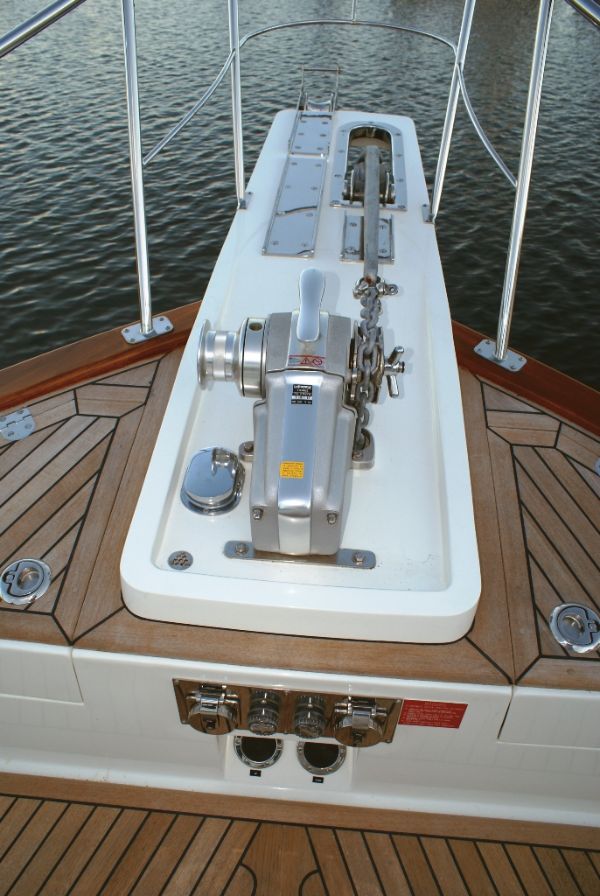
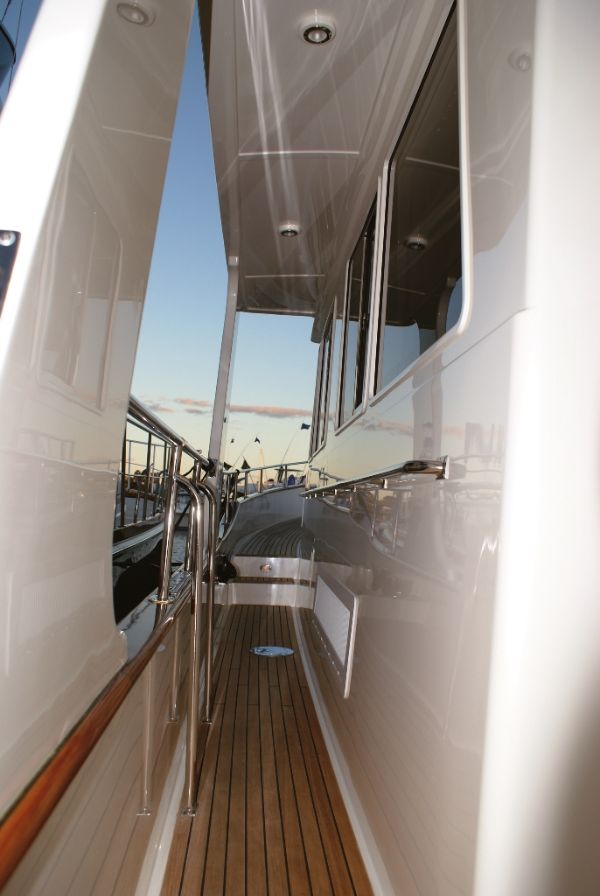
Engine room access from the cockpit is superb. With the assistance of two air struts that ease the lift both up and down, the flybridge stair moulding hinges up to provide almost full standing room clearance down into the engine room. Though this access is off to one side, and the headroom once below deck is just enough to provide clearance over the top of the twin Cat exhausts, there is enough room to get in and around both engines, with teak duckboards laid in between the bearers and hull bracing providing a comfortably secure, dry walking surface under foot.
For access to and from the flybridge, the moulded stairs are user friendly. They are not too steep and with teak inlays for each of the treads and recessed lighting built into the risers these stairs make negotiation up and down quite safe, whether by night or day.
It’s been a couple of years since I was last on a new Grand Banks, and I must say that the company has taken a big leap forward with the design and fit-out of the flybridge. A more enclosed treatment of this upper level via the mouldings for the lounge seats and wet bar has turned this level of the boat into a far more comfortable and user friendly area that offers passengers better protection from the wind and is now far more conducive to entertaining, both while at anchor and underway.
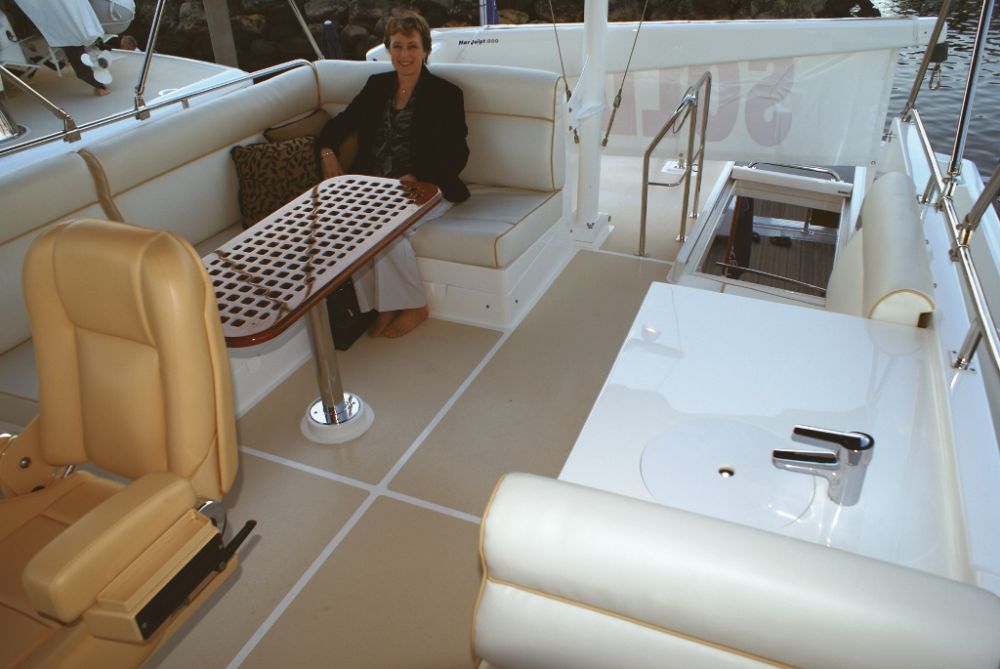
The moulded seat bases are ideal for bulky goods storage, including covers or clears and for life jackets where they can be quickly reached. The bimini top is essential for the climate in most parts of Australasia, and it also improves the general appearance of the boat.
The flybridge deck extends aft almost to the transom of the boat, giving excellent protection to the back cockpit as well as providing the space for the tender cradle and MarQuip 800 davit. Extended also to the side gunwale line, the flybridge overhang gives shading to the saloon windows and protects the side deck walkways. These design features are typical of the GB “Europa” styling!
The detailing and engineering that has gone into the cleats and line leads; the shore power, deck water outlets and the controls for the anchor and deck wash up front, reflect the many years of boating experience that has gone into the design of each model of Grand Banks cruiser.
The quiet ride that marks the Heritage Series just got quieter. One big reason is the exhaust manifolds on the new 47 have been set underwater to deaden running noise even further. Combined with composite soles and state-of-the-art sound insulation materials, it all adds up to one of the most quiet and comfortable cruising experiences at any speed.
Over 3,000 Heritage yachts have been sold since the series was introduced over 40 years ago, and this new model 47 Heritage EU ‘Europa’ will ensure the numbers keep rising!
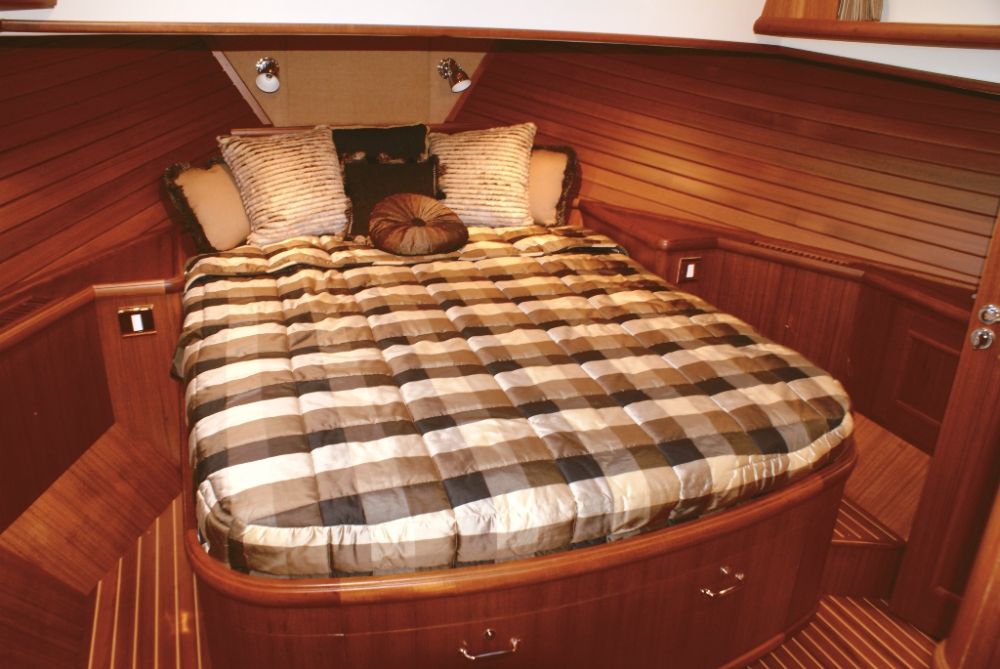
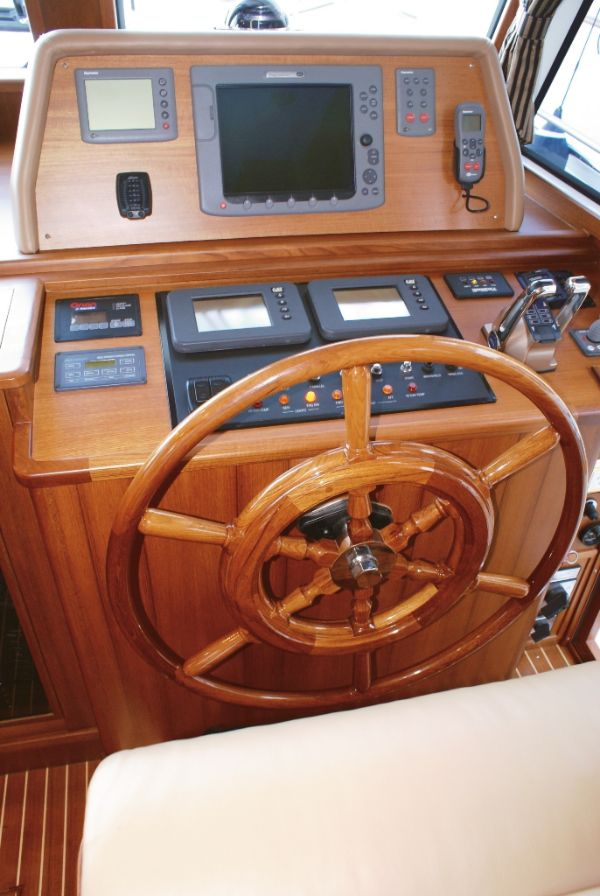
Specifications | Imperial | Metric |
Top Speed | 24 knots | 24 knots |
Maximum Length | 50′ 9″ | 15.47 m |
Length Overall | 46′ 8″ | 14.22 m |
Length Water Line | 44′ 1″ | 13.44 m |
Maximum Beam | 15′ 9″ | 4.80 m |
Maximum Draft | 3′ 10″ | 1.17 m |
Displacement | 50,827 lbs | 23,055 kg |
Fresh Water | 260 usg | 984 Ltrs |
Fuel Capacity | 600 usg | 2,271 Ltrs |
Max Power | 2 x 567hp | 2 x 567hp |




